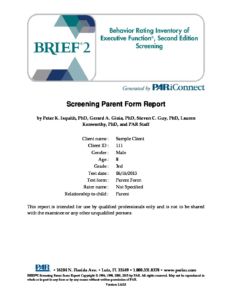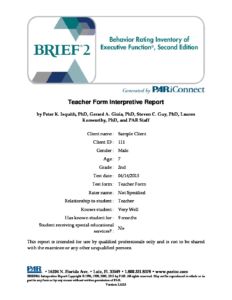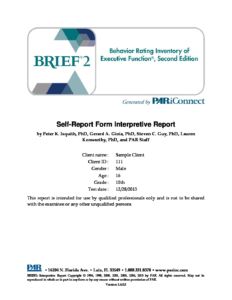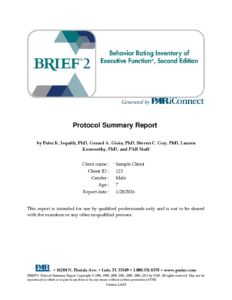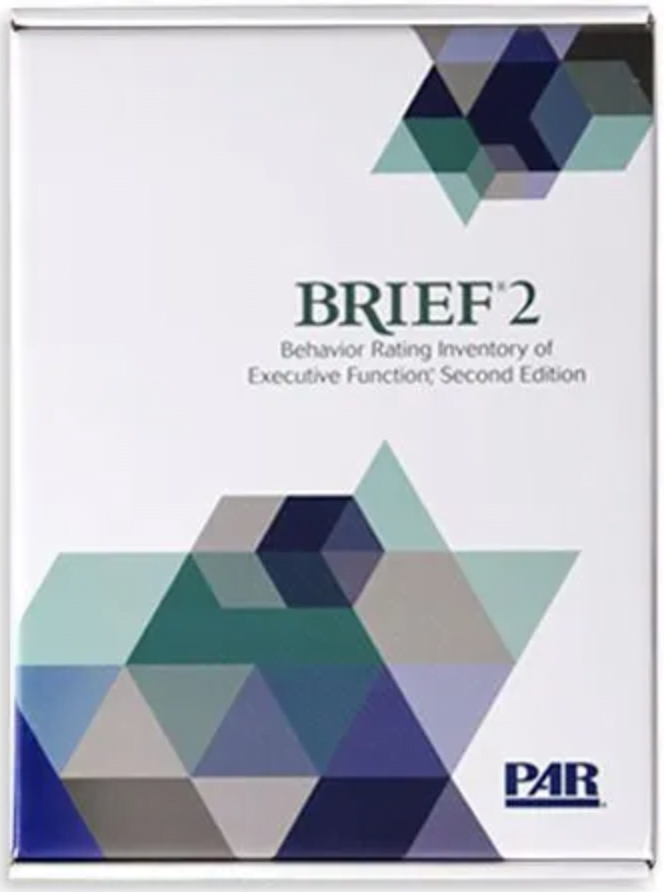
Behaviour Rating Inventory of Executive Function, Second Edition [BRIEF-2]
Used to assess impairment of executive function in children and adolescents
For Ages: 5 – 18 years
Administration Type: Parent, Teacher (adolescents ages 5 – 18 years) and Self-Report (11 – 18 years)
Administration Time: 10 minutes for full assessment; 5 minutes for Screening Form; 15 minutes to score
Format & Scoring: Online administration and scoring via PARiConnect or Hand scored
Authors: Gerard A. Gioia, PhD; Peter K. Isquith, PhD; Steven C Guy, PhD; and Lauren Kenworthy, PhD
Manuals available in hard copy (book) or electronic version (e-Manual)
Online Forms, Reports, Kits & e-Manuals
All online resources including Forms, Reports, i-Admins, Kits and e-Manuals.
Printed Manuals
Physical printed manuals.
Printed Forms & Handscoring Materials
Test forms, response booklets and scoring reference manuals.
Printed Kits
Click to browse products
BRIEF 2 e-Manual (includes Fast Guide e-Manual)
BRIEF 2 online Interpretive Guide (e-Book)
BRIEF 2 online Interventions Handouts (each) min order 5
BRIEF 2 online Parent/Teacher Form i-Admin (each) min order 5
BRIEF 2 online Parent/Teacher Form Interpretive Report (each) min order 5
BRIEF 2 online Parent/Teacher Form Score Report (each) min order 5
BRIEF 2 online Self-Report i-Admin (each) min order 5
BRIEF 2 online Self Report Interpretive Report (each) min order 5
BRIEF 2 online Self Report Score Report (each) min order 5
BRIEF 2 online Screening Parent/Teacher i-Admin (each) min order 5
BRIEF 2 online Screening Parent/Teacher Score Report (each) min order 5
BRIEF 2 online Screening Self Report i-Admin (each) min order 5
BRIEF 2 online Screening Self-Report Score Reports (each) min order 5
BRIEF 2 Parent/Teacher/Self-Report Digital Kit
BRIEF 2 Professional Manual with Fast Guide
BRIEF 2 Interpretive Guide
BRIEF 2 Parent Forms (pack of 25)
BRIEF 2 Teacher Forms (pack of 25)
BRIEF 2 Self-Report Forms (pack of 25)
BRIEF 2 Parent Scoring Summary/Profile Forms (pad of 25)
BRIEF 2 Teacher Scoring Summary/Profile Forms (pad of 25)
BRIEF 2 Self-Report Scoring Summary/Profile Forms (pad of 25)
BRIEF 2 Screening Parent Forms (pack of 25)
BRIEF 2 Screening Teacher Forms (pack of 25)
BRIEF 2 Screening Self-Report Forms (pack of 25)
BRIEF 2 Parent/Teacher Handscored Kit
BRIEF 2 Parent/Teacher/Self-Report Handscored Kit
BRIEF 2 Screening Parent/Teacher/Self Report Handscored Kit
Learn more about the development of the BRIEF 2
The BRIEF 2 is an enhanced rating scale of executive function that continues to be as efficient, comprehensive and consistent with current models of executive function as its predecessor but now includes a quick screener and enhanced features.
The BRIEF 2 includes a 12-item screening version and updated norms for the Parent, Teach and Self-Report forms based on a large, diverse sample.
Features and Benefits
- Provides an overview of the BRIEF 2 model of executive function that leads to assessment and intervention
- Reviews the development, reliability and validity of the BRIEF 2
- Follows two case examples of students with executive function difficulties and describes screen, basic and advanced interpretation
- Increased parallelism in item content, with most items shared between the Parent Form and Teacher Form and approximately half of the items also shared with the Self-Report Form.
- Illustrates the fundamental steps to interpreting scores and introduces optional interpretive steps
- Provides a step-by-step guide to interpret scores and a parallel sentence-by-sentence guide to help practitioners write findings in reports using language that is concise, accurate and clear to parents and teachers
- Contains more concise scales, which reduce the burden on the parent, teacher and adolescent respondent.
- Describes effective executive function intervention models and programs
- Parent, Teacher and Self-Report forms are now discussed in one Manual and have increased parallel structure. This content overlap, combined with the presentation of rater discrepancy base rates, makes examining multiple rater perspectives easy.
The BRIEF 2 Interpretive Guide
The BRIEF 2 Interpretive Guide is intended to facilitate the use of the BRIEF 2. Written by the authors of the BRIEF 2 in a straight-forward, reader-friendly style, this durable hardcover book is designed to assist school psychologist as they assess, plan interventions for and monitor students with executive dysfunction.
Test Structure
Three domains evaluate cognitive, behavioural, and emotional regulation, and a Global Executive Composite score provides and overall snapshot of executive functioning. BRIEF 2 includes 10 clinical scales such as
All forms
- Inhibit
- Self-Monitor
- Shift
- Emotional Control
- Working Memory
- Plan/Organise
Parent & Teacher forms
- Initiate
- Task-Monitor
- Organisation of Materials
Self-Report
form
- Task Copmpletion
Inconsistency, Negativity, and Infrequency scales are all included in BRIEF 2 forms. Print materials include separate Parent (ages 5 – 18 years), Teacher (ages 5 – 18 years), and Self-Report (ages 11 – 18 years) Rating Forms and Parent and Teacher ADHD Forms.
Technical Information
Standardization sample (N = 3,603 total ratings) is matched by age, gender, ethnicity, and parent education level to U.S. Census statistic while clinical data provide support for evidence-based assessment and interpretation of clinical profiles. Reliable change statistics make it easy to measure the significance of change in scores over time.
Online administration in PARiConnect Online account
Leading the way in online assessment. In January 2013, PAR launched their new online assessment platform called PARiConnect. For over ten years, it is one of the most popular platform in the online assessment industry. Updated with features customers asked for, adding trustworthy instruments, PARiConnect remains in-demand-feature in the decades to come.
Why use the Brief-2 online?
- Flexible administration options
- Powerful report options
- Client-centric design
- Reliable verification tools
- Easy and affordable purchase options via PAA website above
- Adaptability for any type of organisation
- Strict data security
- Simple technical requirements
- Enterprise manager





